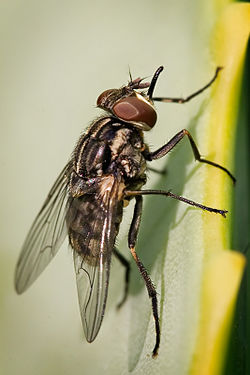| Stable fly | |
|---|---|
 | |
| Scientific classification | |
| Kingdom: | Animalia |
| Phylum: | Arthropoda |
| Class: | Insecta |
| Order: | Diptera |
| Family: | Muscidae |
| Tribe: | Stomoxyini |
| Genus: | Stomoxys |
| Species: | S. calcitrans |
| Binomial name | |
| Stomoxys calcitrans | |
| Synonyms | |
| |
Stomoxys calcitrans is known by the common names stable fly, barn fly, biting house fly, dog fly, and power mower fly. [1] Unlike most members of the family Muscidae, Stomoxys calcitrans ('sharp mouth' + 'kicking') and others of its genus suck blood from mammals. Now found worldwide, the species is considered to be of Eurasian [2] or African origin. [3]
